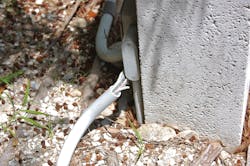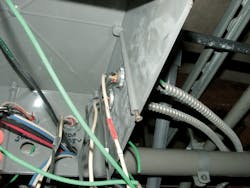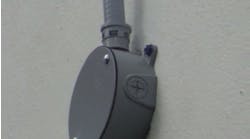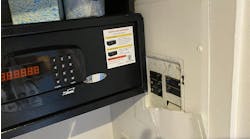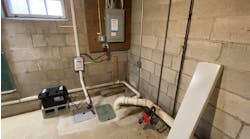All references are based on the 2017 edition of the NEC.
Sun-Drenched Shock Hazard
There are several problems I see with this installation. Let’s start with what I think is the most dangerous. The exposed conductors could pose a real shock hazard if a person or pet were to come in contact with the energized conductors. Even a small nick in the insulation could create a serious danger by allowing stray voltage to energize the surrounding area, especially on a rainy day.
Conductors such as THWN must be installed in a Chapter 3 wiring method as required by Sec. 310.10. This installation comes up a little short on this front. Instead of terminating this PVC conduit into a junction box as required by Sec. 300.12, the installer simply ended the conduit adjacent to the LB fitting and sandwiched the conductors between the cover and the conduit body. I would say this method of terminating the PVC conduit violates the intent of Sec. 352.48.
Another problem with this installation is the conductor’s exposure to the direct rays of the sun. If the conductor’s insulation is not sunlight-resistant, as required by Sec. 310.10(D), over time it will be damaged by the ultraviolet rays of the sun.
“Bush League” Installation
Using nonmetallic junction boxes with metal-clad cables (Type MC) or armored cables (Type AC), while not a very common installation, is not a violation in itself. However, installing a metal-clad cable into a nonmetallic box with no way to establish bonding and grounding continuity between the cable jacket and any equipment grounding conductors is a Code violation. The general rule of Sec. 314.3 requires nonmetallic boxes to be used only with open wiring on insulators, concealed knob-and-tube wiring, nonmetallic cables, nonmetallic flexible cords or nonmetallic raceways. Exception No. 1 of that rule, however, permits metal-armored cables and metal raceways to be used with nonmetallic boxes where an internal bonding means is provided between all raceway and cable entries.
I suppose if this installer had used bonding bushings on each cable connector with bonding jumpers installed to connect all of the metal cables and equipment grounding conductors together, then the bonding and grounding issues would be solved. Without bonding bushings, however, there is no good way to ensure the continuity of these cable jackets. Section 300.10 requires metal cable armor and metal raceways to be metallically connected together into a continuous electrical conductor. One locknut at the back of the box appears to be a grounding type locknut, which would be fine for a metal box but is useless on this PVC box.

